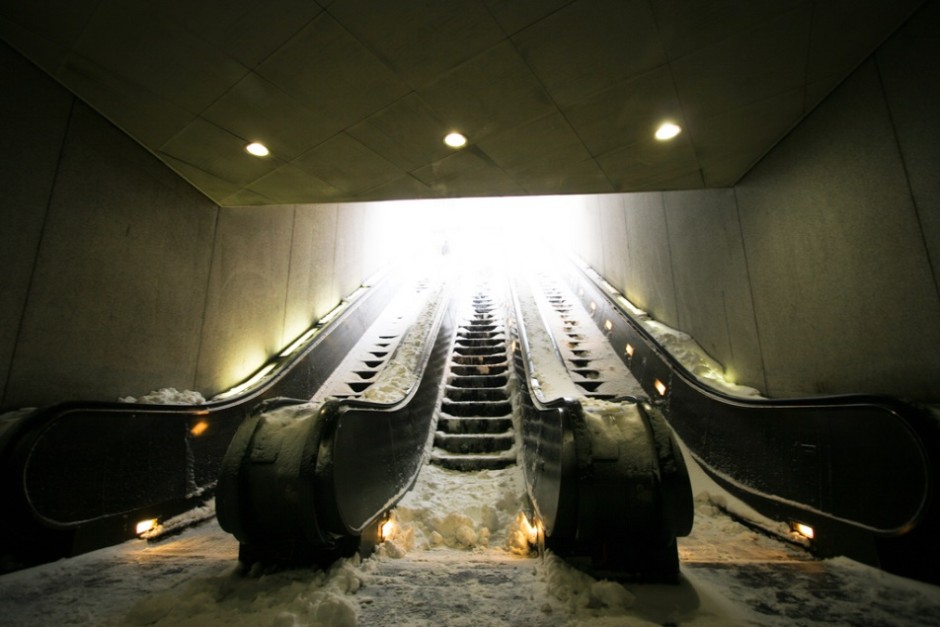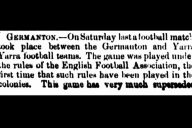Soccer is small, football is big: The cultural dissonance of promotion-relegation in Australia
AFL franchise club Greater Western Sydney won the “wooden spoon” in its inaugural season of 2012 and then again in 2013. A few years before that, in the 2008 and the 2009 seasons, the oldest AFL club, Melbourne, also finished last on the ladder for two years running.
Upon joining the then VFL (now AFL) from the rival VFA competition in 1897, St Kilda won a measly two games in its first six seasons in the competition, finishing last in every single one of those six years. The club has the most number of wooden spoons, 27, in VFL/AFL history.
Of course, in the premier Australian Rules competition it doesn’t really matter if you finish last. Sure, the sponsors might not be so easy to come by, member numbers might fall a little, and supporters might face some taunting from opposition fans, but regardless of how hopeless a club is, there’s always next year. Much like one of those interminable American soap operas like The Bold and the Beautiful or General Hospital clubs in the AFL return year after year, with the competition adding the occasional interstate ‘expansion’ club to its cast of old favourites such as Carlton, Richmond, Collingwood and St Kilda.
Unlike in European football leagues, there is no end of year relegation scrap to keep things interesting at the foot of the table. Teams are awarded draft picks – rather oddly the lower on the ladder you finish the better you are rewarded, which has led to accusations of ‘tanking’ in recent years, including an investigation which saw the suspension of Melbourne’s coach, Dean Bailey, and general manager of football operations, Chris Connolly. Why stress about failure if you get premium picks of the finest young talent on offer?
A similar scenario in relation to promotion and relegation holds sway in Australia’s other major football code competition, the NRL. This is the case even though the premier British rugby league competition has just reinstated promotion and relegation between its Super League and Championship divisions.
Aussie Rules supporters don’t seem too bothered by this lack of pro/rel. In the main they come back year after year to cheer on their team and watch the same cast of heroes and villains when it comes to clubs as they have for pretty much the past 100 or so years.
It’s a culturally accepted status quo, and because of the overwhelming financial clout of the AFL as a monopoly competition, there’s little chance of impoverished second tier clubs from state competitions ever calling for a promotion pathway to become part of the structure of Australian Rules football, or fans pointing to what goes on overseas as an example of change for the domestic competition. The closest case of the former scenario was when successful South Australian club Port Adelaide graduated from South Australian National Football League (SANFL) to the AFL in 1997.
Opposition to the AFL dictate, any pretension to the various state leagues being on an equal footing, was snuffed out more or less when the VFL started on its interstate expansion project with the relocation of South Melbourne to Sydney and the league evolved from being the Victorian Football League into the Australian Football League. The AFL became the undisputed capo dei capi of the sport. Its financial power has well and truly turned state league level clubs into paupers and nurseries.
But the situation is quite different in Australian soccer. The cultural acceptance of a permanent group of clubs – with the occasional financially strategic addition – competing year after year as we see in the AFL and NRL is a “foreign” concept for many soccer fans. Soccer supporters have been conditioned, mainly by exposure to overseas competitions, to think differently about the merits of keeping and earning your place in a league.
The pro/rel morality tale
The prevailing culture in soccer globally is for teams to live and die by their results on the field, for clubs to fight year after year for their survival and success. This mindset takes on an almost moral dimension: this team “deserved” to get promoted, while this other team might have been “hard done by” to be relegated. Fans greet promotion with delirious joy; while relegation is met with despair. That moral dimension becomes part of the narrative of pro/rel; it imbues even greater depth into the story arcs of clubs and the experience of supporters identifying with those clubs.
This deep emotional and moral investment means that, along with derby games, the annual saga of promotion and relegation is one of the strongest narrative tropes in world football.
Each season, supporters of teams in all the major and minor football leagues across most of the world (save Australia and the US) get on this rollercoaster ride of emotion. Likewise, clubs invest big amounts of money in fending off relegation or in seeking promotion. A club’s promotion or relegation is almost entirely tied to its on-field performances, which you could argue, provide some indicator of a club’s off-field performance and health – though not always.
Last season, for example, saw the ascent of Bournemouth AFC to the English Premier League; Carpi FC to Italy’s Serie A; FC Ingolstadt to the German Bundesliga; and in Spain, Eibar to La Liga. It was the first time each of these clubs was competing in the top flight. While these clubs were moving up to take their place among the elite of their respective national competitions, other clubs were moving down to make way for them. Clubs such as Queen’s Park Rangers, Parma, SC Paderborn, and Cordoba were all relegated last season, each undertaking its own particular journey of suffering for fans.
Bournemouth won promotion to the top flight for the very first time in its 126 year history. Its squad is valued at about $A140 million (£68 million) and its home ground, Vitality Park, has a seated capacity of 11,500. Compare that to last season’s champions, Chelsea, whose squad is valued at $A780 million (£380 million), and whose home ground, Stamford Bridge, holds 42,000 fans.
This year, Bournemouth is holding its own in a respectable lower mid-table position, while Chelsea has fought its own demons to fend off the (admittedly faint) prospect of relegation. At the time of writing, there’s two points between the clubs after 25 matches of the season. When Chelsea won the Champions League in 2012, Bournemouth finished the season in 11th place in League One (English football’s 3rd tier).
In narrative terms, this is a huge victory for Bournemouth and a fall from grace for Chelsea. Those respective interpretations are deduced from the knowledge we have of each club’s background, history and past performances. That is the beauty, romance and attraction of the promotion and relegation system: supporters, even neutral ones, are able to invest in the story arc of clubs as they scale and descend the mountain. These are big stories played out over time on a stage that takes in major actors and bit-part players.
While Chelsea is unlikely to be relegated, it looks almost certain that Aston Villa will be. Villa is one of the grand old clubs of English football and the winner of the 1982 European Cup – an archetypal sleeping giant – which faces the prospect of playing against minnows such as Burton Albion and Brentford in the Championship rather than Manchester United and Liverpool next season. At the top of the table, unlikely title contenders Leicester City won promotion to the Premier League from the Championship for the 2014-15 season after almost about a decade in the second tier league.
Additional dramaturgical scope in narrative terms comes from the fact these clubs can fall very low (non-league) and climb to very high positions (European Cup/Champions League winners). This is perhaps best demonstrated by the longer term narratives of clubs like Nottingham Forest and Leeds United, respectively European Cup winners (Forest won the cup in 1979 and 1980) and runners-up (Leeds lost to Bayern Munich in the 1975 final). Both clubs have been up and down between the second and third tiers of the English leagues for the past decade. The glory days of Forest now seem about as past and mythic as the tales of that other favourite son of Nottinghamshire, Robin Hood; while Leeds seem to be in a permanent mode of ownership crises.
Australian football and the argument of exception
Australian soccer fans know these stories well. Australia’s soccer culture has always looked towards Europe, and the UK especially. Compare that to the AFL, where the culture is insular and almost totally self-absorbed. AFL fans can’t point to anywhere to say ‘this is how it’s done there, why don’t we do that?’ because (to quote Gertrude Stein’s quip about Oakland) “there is no there there.”
The culture of the AFL is limited to the AFL, and the AFL has never had promotion or relegation. The culture of soccer is essentially global, and the rest of the world has promotion and relegation, so why don’t we?
The main defence mounted by those who argue for the current regime of not having pro/rel in Australia between the A-League and either a yet to be created second tier national comp or top tier state comps is based upon exceptionalism. This exceptionalism is expressed in relation to two factors: the hyper competitive and commercial nature of Australia’s sporting landscape consisting of four major football codes (Aussie rules, rugby league, soccer, rugby union); and that Australian soccer is not commercially strong enough (yet) to sustain multiple tiers of professional football. (Of course, the second factor is an inductive conclusion drawn principally from the first factor.)
Another element of the exceptionalist argument used to be that the geographical size of the country and the cost of travel made it extremely difficult to sustain much more than maybe 14 teams in a professional premier league. The relative fall in air travel costs has diminished this argument to a great degree. Though some would argue, regardless of cheaper air travel, the total costs of running a professional club are still well beyond the reach of most state level semi-professional clubs.
Either way, the end result is that promotion and relegation is seen as a naive dream, usually advocated by ‘NSL bitters’ who support clubs like South Melbourne and Sydney United and long for the day their club can be restored to former glories. The argument advocating for the status quo assumes the realist position, even though that position is predicated on a reality constructed on an inorganic, hyperreal commercial premise – it’s perhaps apt that the father of the A-League concept is Frank Lowy, a shopping mall magnate. French theorist Jean Baudrillard’s theory of hyperreality, applied as it was to modern shopping malls, could maybe as easily be used to critique the realness of the A-League’s franchise clubs.
The A-League simulacra and its “profound reality”
But to take Baudrillard’s theory a step further, critics may call A-League clubs ‘plastic’ simulations of ‘real’ clubs, but then as long as these simulated clubs exhibit the signs of being real how can the criticism hold valid? Melbourne Victory, a decade into its existence, seems very much a real club to its fans and enemies alike. Melbourne City, maybe less so.
Baudrillard’s “phases of the image” gives us an interesting parallel to the way in which the A-League and its clubs were conceived out of the commonly perceived and acknowledged crisis that had beset Australian soccer in the early 2000s leading up to the dissolution of the NSL and the creation of the A-League.
“Such would be the successive phases of the image:
- it is the reflection of a profound reality;
- it masks and denatures a profound reality;
- it masks the absence of a profound reality;
- it has no relation to any reality whatsoever;
- it is its own pure simulacrum.”
Of course that “profound reality” in this case is what people sometimes refer to as “old soccer” while the image transformed as simulacra is “new football”. The willingness of the new regime, led by Lowy, to assert a new identity by the symbolic naming rite of shedding soccer and embracing the global, universal nature of the name football was just one way in which the profound reality of old soccer was to be masked and denatured.
The project set out to plug into the global symbolic power of football but packaged in such a way as to appease and ameliorate the exceptionalisms that have long plagued the sport in Australia. Among these exceptionalisms, as mentioned earlier, was the aversion to pro/rel, along with other elements such as extreme fan culture (flares, foreign flags, political banners, etc), a fondness for finals rather than first-past-the-post, and a heap of other miscellaneous matters. The point-of-difference and spectacle of fan culture has been used by the FFA for marketing purposes while the governing body has grappled with negotiating the rough, anarchic edges of that culture. The FFA has been made all too aware that A-League fans won’t sit down, shut up and clap at the appropriate moments.
The matter of pro/rel looms large on the sport’s landscape in Australia because it is essentially about the healing of the great schism. The ongoing cultural dissonance between the status quo adherence to an A-League without pro/rel – which only expands or contracts according to the dictates of head office – and the calls for the sport to adopt an open system that could conceivably see the “profound reality” of ethnic-based clubs, as well as the multitude of community-based clubs, integrated into the simulacra of the A-League is at the heart of the sport’s attempts to define itself.
Will football be the biggest sport in Australia, as measured by the sort of metrics one might apply to a shopping centre, or will it merely slide back into being soccer, a fringe football code enormously popular globally but just one of the four codes played and watched in this country? Can the ramshackle charms of High Street be allowed to penetrate the climate-controlled shopping mall?
The almost universal narrative of pro/rel, played out in big leagues and small throughout the world, stands as an example and aspiration for football in Australia. But the recital of the supposed exceptionalisms holding the sport back in this country expose the narrative black hole at the heart of the Australian football story. The narrative power of pro/rel could hold the key to healing the schism, or else it might just demonstrate that without the projected might of the A-League simulacra, soccer really is just a minor sport in this country after all.
Feature image courtesy of Bill Couch via Flickr.

















This is far too thoughtful for the Australian sporting discourse.
Great piece.
Great insight. Relieved I’m on the same side as you.